Humans waste so much food.
Before throwing away the stub of your celery or the top of that carrot, learn how to regrow foods from the scraps left behind and become more self-sufficient.
Self-sufficiency is essential. While we can’t all be off-grid farmers, many vegetables can be regrown from leftover table scraps.
Using scraps to regrow food can help you save money on pricey vegetables and aid in future preparation.
Potatoes
You can regrow potatoes by cutting an old potato into small pieces. Ensure that each piece has one eye.
Let the pieces dry for a few days, and plant them in soil; water regularly to ensure the soil stays moist.
Sweet Potatoes
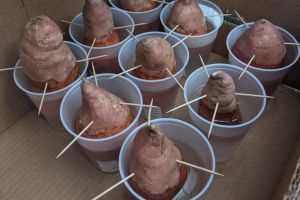 Cut a sweet potato in half and suspend it in a glass of water with toothpicks. The bottom half of the sweet potato should be in the water, while the top half should be exposed to air.
Cut a sweet potato in half and suspend it in a glass of water with toothpicks. The bottom half of the sweet potato should be in the water, while the top half should be exposed to air.
After a few weeks, roots should start growing from the sweet potato’s bottom half.
Related: How To Can Potatoes for Long Term Preservation
Once the roots are a few inches long, you can plant the sweet potato in soil.
Green Onions
Cut the roots off a green onion, leaving about an inch of the white part intact, and place them in a jar or glass with water covering the roots.
Change the water every couple of days, and within a week or two, you should see new shoots starting to grow.
White or Yellow Onions
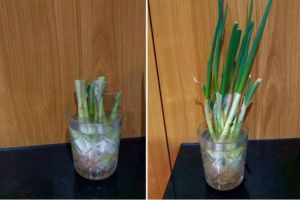 Cut the bottom off an onion and place it in soil with the cut side down.
Cut the bottom off an onion and place it in soil with the cut side down.
Within a few days, you should see new shoots starting to grow.
As the shoots grow taller, you can harvest the green onion tops and use them in recipes.
Garlic
Take a clove of garlic and plant it in a pot or in your garden with the pointed end facing up. Within a few weeks, you should see a new garlic plant starting to grow.
Shallots
Separate a shallot from the clove. Place the cloves in a container, pointed end upwards, cover with soil, and care for as you would any other plant.
Leeks
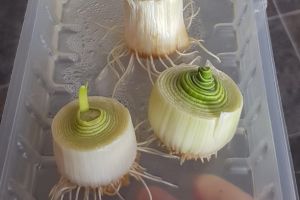 Grown in the same way you re-grow green onions, cut a leek a few inches from the base and place them in a bowl of water until they start growing roots, then plant them in soil.
Grown in the same way you re-grow green onions, cut a leek a few inches from the base and place them in a bowl of water until they start growing roots, then plant them in soil.
Related: 10 Vegetables That You Can Stockpile Without Refrigeration For A Full Year
Beets
Cut off the top of a beet and place it in a shallow dish of water, cut side down. Within a few days, you should start to see new green shoots emerging from the top of the beet.
Once the shoots are a few inches tall, you can plant the beet in soil and continue to grow it.
Lemon
Save the seeds from a lemon and plant them in soil. The lemon tree may take a while to grow and produce fruit, but it is possible.
Avocado
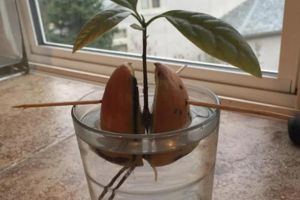 Take the pit from an avocado and clean it off. Then, using toothpicks or a flipped bottle top, suspend the pit in a glass of water with the pointed end up. Keep the water level consistent, and within a few weeks, roots should start to grow. Once the roots are about an inch long, you can plant the avocado pit in soil.
Take the pit from an avocado and clean it off. Then, using toothpicks or a flipped bottle top, suspend the pit in a glass of water with the pointed end up. Keep the water level consistent, and within a few weeks, roots should start to grow. Once the roots are about an inch long, you can plant the avocado pit in soil.
Carrots
Cut the top off the carrot, leaving a bit of the green leaves intact, and place it in a shallow dish of water. Change the water every couple of days, and within a week or two you should see new green leaves starting to grow.
Turnips
Cut off the top of the turnip and place it in a dish of water cut side down. Place the dish in a sunny place and change the water every few days. Once you see emerging shoots that are a few inches long, plant the turnip in soil and water regularly.
Celery
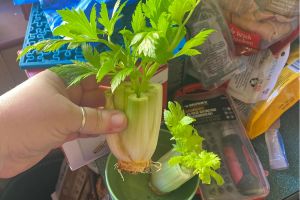 Cut the base of the celery, leaving a couple of inches of stalk intact, and place it in a bowl with about an inch of water.
Cut the base of the celery, leaving a couple of inches of stalk intact, and place it in a bowl with about an inch of water.
Change the water every couple of days, and within a week or two, you should see new leaves starting to sprout.
Related: Edible Plants To Forage In Early Spring
Tomatoes
Take a slice of tomato, bury it in soil, cut side down. You should see new tomato plants growing from the buried slice within a few days.
Peppers
Growing peppers is as easy as saving the seeds and planting them in soil. Within a few weeks, you should see new pepper plants starting to grow.
Pineapple
Cut the top off a pineapple and remove the bottom few leaves. Let it dry for a few days, then plant it in soil. Pineapple plants take a long time to grow, but with patience, you can grow your own pineapple at home.
Lettuce and Other Leafy Greens
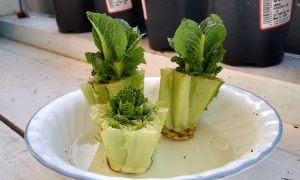 Cut the base of the lettuce, leaving a few inches of stem intact, and place it in a bowl with about an inch of water.
Cut the base of the lettuce, leaving a few inches of stem intact, and place it in a bowl with about an inch of water.
Change the water every couple of days.
You should see new leaves starting to sprout within a week.
Cabbage
Cut off the bottom of the cabbage, leaving a few inches of stem. Place this scrap into a bowl of water, cut side down, changing the water every few days.
⇒ What Happens If You Pour Salt Into A Cabbage
You should see new leaves starting to form after a few days. Once these leaves are a few inches long, plant the cabbage in a pot or the ground.
Basil
Cut a few basil stems and place them in a glass of water. Change the water every couple of days and within a week or two, roots should start to grow. Once the roots are about an inch long, you can transplant the basil into a pot.
Mint
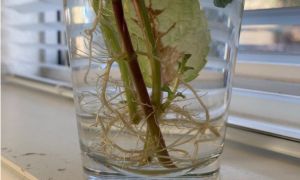 Cut a few stems of mint and place them in a glass of water. Change the water every couple of days, and the roots should start growing within a week or two.
Cut a few stems of mint and place them in a glass of water. Change the water every couple of days, and the roots should start growing within a week or two.
Once the roots are about an inch long, you can transplant the mint into a pot.
Thyme
Cut a few stems off a bunch of thyme and place them in a glass of water. Change the water every couple of days, and the roots should start growing within a week or two. Once the roots are about an inch long, you can transplant the thyme into a pot.
Rosemary
Cut a few stems of rosemary and place them in a glass of water. Change the water every couple of days and within a week or two, roots should start to grow. Once the roots are about an inch long, you can transplant the rosemary into a pot.
Sage
Cut a few stems of sage and place them in a glass of water. Change the water every couple of days, and within a week or two, the roots should start to grow. Once the roots are about an inch long, you can transplant the sage into a pot.
This is not an exhaustive list.
Many foods can be re-grown from scraps and stems, or by using their seeds. For example, foods like tomatoes or apples can be re-grown from their seeds. While using seeds takes much longer, it can be done.
With patience and a green thumb, you can grow your own foods and save a ton of money at the grocery store, which is handy every day but is especially useful during a crisis.
Stop spending all your money on things you can grow, and start preparing for the future.
What other plants can you grow from scraps? Which ones do you grow at home?
You may also like:
 Supposed CIA Operative Caught With 1200 Guns and 2 Tons of Ammunition. What Was He Prepping For?
Supposed CIA Operative Caught With 1200 Guns and 2 Tons of Ammunition. What Was He Prepping For?
How To Make A Year-Round Self-Sustaining Garden (Video)
Best Dogs To Have Around For SHTF

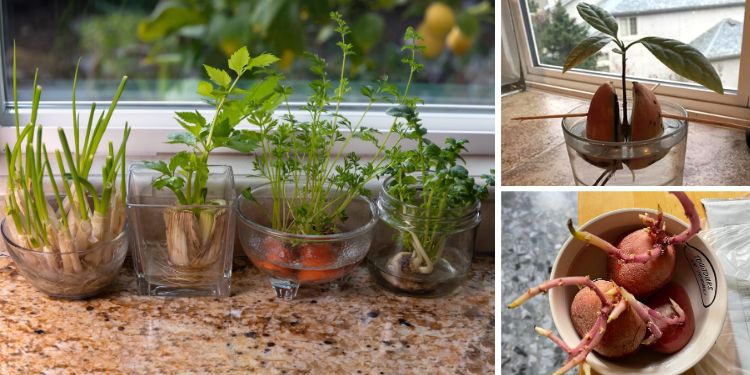



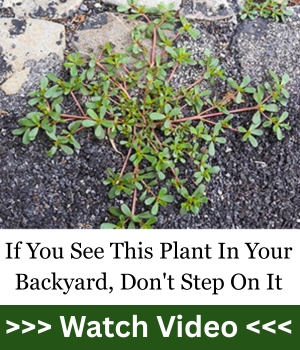



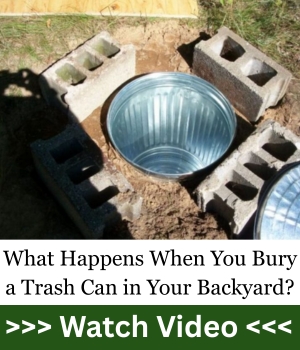






Wellllll…… after the leaves start growing on the carrots, celery, and lettuce etc. what next? Do you plant it in dirt or leave it in the dish???
Plant them in the dirt. Be sure depending on your area for the last frost freeze date. Farmer’s Almanac gives a rough estimate date for last frost before planting the garden.
Not sure if you knew this Pat, but some of those items such as carrots, and parsnips will not produce an edible root grown this way.
What you will get is seeds that can be planted for next years harvest.
FYI: an apple (or any fruit) seed will not bear fruit if it grows into a tree (its 100,000 to 1 shot), all nurseries “Graft” from a fruit bearing tree to a non bearing tree, then when the good graft becomes large enough they begin to cut off the old non bearing portions until just the good bearing grafted part remains….DBI : call a nursery. inventpeaceNotWar
Just tilled the garden
to which I found that the carrots from last year s harvest left in the ground were intact and ready for harvest , wow did not expect to last thru winter in ground 6 months
I covered the garden with plastic bags for new soil , and this is what i found
This is information that should be taught to anyone who likes to eat…ThankYou
To bad this is not taught in grade school, like home EC and shop classes use to be in high school. Students are more likely to do social media stupid human pet tricks, then learn to feed themselves.
When I was growing up on a farm in the 60’s, regarding regrowing vegetables, it was not a new thing to us, it was our way of life. Everyone in our family, all of the neighbors down the street knew how to live this way. Our family, hardly ever purchased store-bought vegetables. For the most part that was unheard of. There is nothing like growing your own food. The food taste better then store-bought. You know that no deadly pesticides were used. And you will have fresh food to eat on a regular basis. If not for you, think about your children, I am absolutely sure that they will appreciate it.
Did also learn to do seed saving of your vegetables?
I’m not sure if this website ever did an article on seed saving methods.
That would be useful info for us.
One thing about checking spelling or sentences is we can’t go back to correct the mistake.
Here is what I found on seed harvesting on this website:
How To Harvest These Seeds For SHTF
8 Plants That You Need To Know How To Harvest Seeds From
Ask a Prepper website did an article on seed saving/seed preparation–seed saving some time back. Given the current costs of starter plants and seeds ti would behoove everyone to learn to save seeds. One of the biggest garden dangers when growing veggies from seed is stem rot which is due to watering directly on the stem of the baby plants so water AROUND the plant, NOT ON the seedling plant. Also, rabbits and mice will devour small seedling plants so take measures to protect your veggie plants until these get bigger.
Tomatoes are super easy to grow I had a break in my septic system one winter due to a hard freeze. For about 2 months sewage leaked into my yard until the ground thawed enough to dig up and fix the lines. Come spring time, all these little plants started popping up in the yard. They turned out to be healthy and vibrant Tomato plants! The little seeds we ate with the tomatoes somehow avoided our teeth, pass through our digestive tract, pushed on through the toilet system, escaped through the breaks in the septic system line, and made themselves right at home in the front yard. Healthiest plants I ever seen. Great tomatoes too (kids wouldn’t touch them, but heck, what do they know?).
Great article! I have tried to regrow some of those plants, that is no problem. The bad part is planting them in the garden area. These past 2 years the rats and mice have stalked the growing plants. Had a coyote decide to investigate, it only ate the leaves left the plant stocks to survive.
We do have a rabbit fence surrounding the garden. It’s the rats getting through the holes. This year have use some liquid rat poison fenced off from the birds. It is doing the job, dislike to use chemicals except for last resort. Trying a couple of those rat and mice drop bucket traps this year.
Otherwise good info to starting plants in a shorter time than using seeds.
@ bob2
Get some oatmeal and some baking soda and mix two to three tbs of baking powder to one cup oatmeal and then put it out for the rats and mice.
It will not kill anything else, but it will put a gas bubble in their stomach and KILL the Rats and the Mice. They can’t burp, so they blow up and die…
Don’t know about the rabbits.?
Stay sharp
About growing Avocados, My Grandmother always had a green thumb, herbs on the windowsill, and such. And she always had a few Avocado plants around. One of these avocado plants grew quite long, well over 20 feet long, but it NEVER grew any fruit. Did I miss something??
The nursery store bought trees, like Avocados have grafted root stocks. That may make the difference for getting fruit. Am sure a horticulturist can explain better why you did not have any fruit from that tree.
Frank C.
There are male and female Alvacado’s. There is a way that you can tell the sex, but I can’t remember.
Some plants will never produce fruit. They will grow, But…
stay sharp
Mostly very good, but not really the trees (lemon and avocado); most of the world doesn’t have the climate to grow them.
Ten or twelve years ago, I found seeds inside a lime already sprouting. I planted them, and I now have 3 lime trees about 6 feet tall. They are in very large pots, and it is a definite pain to haul them in to my large south-facing living room windows every fall, but all three of them have produced limes. Not enough limes for my margaritas, but some… I’m sure I could do a better job of caring for them and get a better yield, but I’m in Northern Indiana, so I’m just happy I’m growing citrus, lol!
Rather than cutting the sweet potato in half and trying to keep it suspended in a jar of water that will start to rot and smell, leave it whole and place it sideways in a pot of damp sand, seed starter mix or coconut coir, buried only half way up its sides. After a couple of weeks, you should get slips (stems with leaves on them) growing out of the potato. Twist them off, stick them in a jar of water and they will start to grow roots. When the roots are a few inches long, place them in the garden or a large pot of soil. The vines will take over their immediate area but if you weave them through a fence or trellis, you can create a living fence and keep them under control. They will produce lots of edible roots and the leaves can be added to salads. I have heard that the leaves are also used in Asian cooking. I feed them to my chickens and Guinea fowl to give them fresh greens throughout the summer and fall.
I have had very good luck with the celery and green oinions… but they were all dead when I cam back from a vacation in the CSSR. (California Soviet Socialist Republic) So I started up again, and this time I soaked the pots well and filled the plants that were still in water to the top. I put as many as I fit into the kitchen sink and put a few inches of cold water in there. The sink is in a lower area behind a wall where sunlight cannot hit iit, but below windows so there is SOME, but not a lot of alight. Upon my return, it just starting to get dry, but most of the plants recovered with watering. Next on the agenda will be “Chinese Stinky Weed”, it is sort of like garlic chives, adds a delicious taste to many foods, and comes from a nation that practices peace, freedom, social justice, economic democracy, and racial, education, disability, and gender equity while banning all private ownership of lethal high-power military assault weapons and unauthorized reproduction. They also practice organ donor diversity. At least they get good food before they are sent to the organ transplant center at gunpoint. If they are lucky and have a good social merit score, it will only be only one kidney, and not two.
Horseradish, from scraps or leaves.
I just wanted to know what happens when one puts salt on a Cabbage.
Larry Ellis
I can’t comment on most of these however the avacado and the lemon will be seedlings i.e. they probably will not have the same characteristics as the fruit they came from . Most “fruits” are grafted in a nursery to a variety that is useful for fruit production.
You will have a “wild” lemon or avacado or apple or orange or pecan tree that may take years to produce a small or poor crop.
Alan the same is true for apple seeds, too. Even if you take apple seed from a tree that wasn’t grafted.